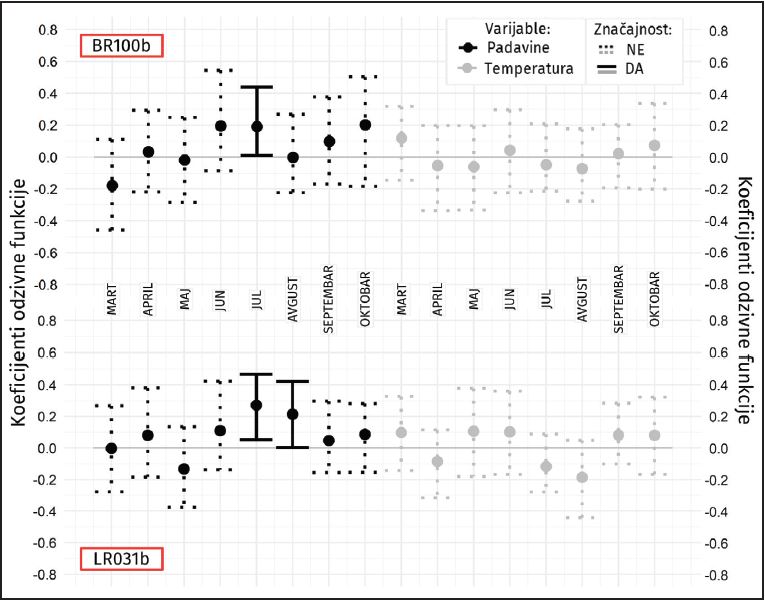Dendroecological research in the sessile oak stands on the warmer site conditions of the Đerdap National Park, Serbia
DOI:
https://doi.org/10.7251/GSF2434001RKeywords:
climate influence, Đerdap, radial increment, Sessile oakAbstract
Although oaks are one of the dendrochronologically/dendroecologically most studied tree species in Europe, one of the regions where such research has not been carried out much is the area of Serbia. Therefore, the main goal of this study is to analyze and determine the nature of the dependence between the radial growth of the oak trees on the air temperature and the amount of precipitation in two stands in warmer site conditions in the Đerdap National Park. Stand BR100a is located in Management Unit "Boljetinska reka", compartament 100, stand a, and stand LR031b in MU "Leva reka", compartament 31, stand b. BR100a is located at approximately 395 m above sea level, on a southern slope and classified as Quercetum montanum tilietosum tomentosae Mišić 1997, and LR031b belongs to the community Querco-Fagetum Glišić 1971 and is located at approximately 590 m above sea level, on a south/southwesthern exposure. In order to analyze the radial increment, define master chronologies, and determine the common signal in the growth of the Sessile oak and the dependence of the increment on the climate elements, the dominant trees of this species were cored (20 trees in BR100a and 18 trees in LR031b), with two cores from each tree at the height of 1.3 m. Measurements of the total size of radial growth (RW), early- (EW) and late-wood growth (LW) were made. Standard dendrochronological- statistical indicators were used to quantify the level of agreement between the tree’s growth pattern within the sample, and and generally the quality of the sample, both for empirical and a series of growth indices of all increment components (chronologies). To assess the influence of temperature and precipitation on the growth of this tree species four methodological approaches were used: (1) correlations between three-month (seasonal) temperature and precipitation values with residual chronology, (2) correlations between monthly temperatures and precipitation with residual chronology, (3) the so-called response functions and (4) correlation between SPEI drought index with residual chronology. The research results on the reaction of the sessile oak from two stands in the NP "Đerdap" showed that this tree species in warmer sites is sensitive to the amount of precipitation in the summer months, when higher amounts of precipitations, especially in July, lead to the formation of significantly higher annual radial increment amounts and vice versa. The results of the application of the SPEI drought index also showed that wetter abundance is especially favourable for the Sessile oak in such site conditions, where the lack of precipitation in combination with high evapotranspiration can significantly reduce growth and create conditions for the occurrence of devitalization of trees. The observed initial, slightly alarming indications of less successful growth and reduction in the vitality of trees and forests of this tree species nowadays when there are reduced precipitation and more pronounced temperatures compared to the multi-decade averages, are partly mitigated by the results showing that the variations of growth sessile oak are much less affected by temperature variations than precipitation. Such observation indicates that oak, even in warmer sites, is still sufficiently resistant to the negative impact of above-average temperatures in the summer months. Expectedly, it was determined that a stronger climate signal was detected in the total size of the radial increment and the increment of LW than in the increment of EW. The obtained results have a preliminary character, bearing in mind that the goal of this work was to acquire basic knowledge about the dendroecological response of the oak in two localities within the area of NP "Đerdap". In order to make much more detailed conclusions about the dendroclimatological reaction of the oak trees in these, but also in other site conditions, additional research is necessary, which will expand the existing knowledge about the influence of climate on the growth of this tree species and enrich the spectrum of the obtained results.

Downloads
Published
Issue
Section
License
Copyright (c) 2024 Nenad Radaković, Branko Stajić, Marko Kazimirović, Vojislav Dukić, Damjan Pantić

This work is licensed under a Creative Commons Attribution 4.0 International License.